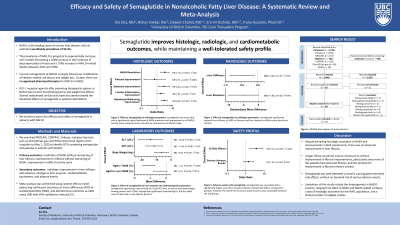Tuesday Poster Session
Category: Liver
P3801 - Efficacy and Safety of Semaglutide in Nonalcoholic Fatty Liver Disease: A Systematic Review and Meta-Analysis
Tuesday, October 24, 2023
10:30 AM - 4:00 PM PT
Location: Exhibit Hall

Has Audio
.jpg)
Kai Zhu, MD
University of British Columbia
Vancouver, BC, Canada
Presenting Author(s)
Kai Zhu, MD, Rohan Kakkar, BSc, Daljeet Chahal, MD, Eric M. Yoshida, MD, Trana Hussaini, PharmD
University of British Columbia, Vancouver, BC, Canada
Introduction: Non-alcoholic fatty liver disease (NAFLD) is the leading cause of chronic liver disease, with an estimated worldwide prevalence of 32.4%. Unfortunately, to date, there are no approved pharmacotherapies for NAFLD or non-alcoholic steatohepatitis (NASH). The aim of this study was to assess the efficacy and safety of semaglutide in patients with NAFLD.
Methods: MEDLINE, CENTRAL, and Embase were searched from inception to May 1, 2023, to identify eligible randomized controlled trials (RCTs). Meta-analysis was performed using random effects model expressing continuous outcomes as mean differences (MD) or standardized mean differences (SMD), and dichotomous outcomes as odds ratios (OR) with 95% confidence intervals (CI). Statistical heterogeneity was assessed using the Cochran’s Q test and I2 statistic.
Results: Three RCTs involving 458 patients with NAFLD were included. Semaglutide improved histological outcomes compared to placebo, with significantly higher likelihood of NASH resolution (OR 3.18, 95% CI 1.70 to 5.95, I2=0%), improvement in steatosis (OR 2.83, 95% CI 1.19 to 6.71, I2=57%), lobular inflammation (OR 1.81, 95% CI 1.11 to 2.96, I2=0%), and hepatocellular ballooning (OR 2.92, 95% CI 1.83 to 4.65, I2=0%), but not fibrosis stage (OR 0.71, 95% CI 0.15 to 3.41, I2=80%). Radiologically, semaglutide significantly reduced liver stiffness (SMD -0.48, 95% CI -0.86 to -0.11, I2=57%) and steatosis (MD -4.96%, 95% CI -9.92 to 0.01, I2=64%). It also significantly reduced ALT (MD -14.06 U/L, 95% CI -22.06 to -6.07, I2=0%) and AST (MD -11.44 U/L, 95% CI -17.23 to -5.65, I2=0%).
Patients treated with semaglutide had improved cardiometabolic outcomes, including greater decreases in HgA1c (MD -0.77%, 95% CI -1.18 to -0.37, I2=75%) and weight loss (MD -6.53 kg, 95% CI -11.21 to -1.85, I2=0%) compared to the placebo. However, semaglutide was associated with higher occurrence of GI-related side effects (OR 3.72, 95% CI 1.68 to 8.23, I2=49%), but the overall risk of serious adverse events was comparable between the two groups (OR 1.40, 95% CI 0.75 to 2.62, I2=0%).
Discussion: Semaglutide demonstrated significant improvements in NASH resolution and NAFLD Activity Score components, but not in fibrosis stage. Furthermore, semaglutide resulted in radiologic improvements in liver stiffness and steatosis, liver enzymes, and cardiometabolic outcomes while maintaining a well-tolerated safety profile. Further trials of longer duration are needed to investigate its efficacy in fibrosis regression.
Disclosures:
Kai Zhu, MD, Rohan Kakkar, BSc, Daljeet Chahal, MD, Eric M. Yoshida, MD, Trana Hussaini, PharmD. P3801 - Efficacy and Safety of Semaglutide in Nonalcoholic Fatty Liver Disease: A Systematic Review and Meta-Analysis, ACG 2023 Annual Scientific Meeting Abstracts. Vancouver, BC, Canada: American College of Gastroenterology.
University of British Columbia, Vancouver, BC, Canada
Introduction: Non-alcoholic fatty liver disease (NAFLD) is the leading cause of chronic liver disease, with an estimated worldwide prevalence of 32.4%. Unfortunately, to date, there are no approved pharmacotherapies for NAFLD or non-alcoholic steatohepatitis (NASH). The aim of this study was to assess the efficacy and safety of semaglutide in patients with NAFLD.
Methods: MEDLINE, CENTRAL, and Embase were searched from inception to May 1, 2023, to identify eligible randomized controlled trials (RCTs). Meta-analysis was performed using random effects model expressing continuous outcomes as mean differences (MD) or standardized mean differences (SMD), and dichotomous outcomes as odds ratios (OR) with 95% confidence intervals (CI). Statistical heterogeneity was assessed using the Cochran’s Q test and I2 statistic.
Results: Three RCTs involving 458 patients with NAFLD were included. Semaglutide improved histological outcomes compared to placebo, with significantly higher likelihood of NASH resolution (OR 3.18, 95% CI 1.70 to 5.95, I2=0%), improvement in steatosis (OR 2.83, 95% CI 1.19 to 6.71, I2=57%), lobular inflammation (OR 1.81, 95% CI 1.11 to 2.96, I2=0%), and hepatocellular ballooning (OR 2.92, 95% CI 1.83 to 4.65, I2=0%), but not fibrosis stage (OR 0.71, 95% CI 0.15 to 3.41, I2=80%). Radiologically, semaglutide significantly reduced liver stiffness (SMD -0.48, 95% CI -0.86 to -0.11, I2=57%) and steatosis (MD -4.96%, 95% CI -9.92 to 0.01, I2=64%). It also significantly reduced ALT (MD -14.06 U/L, 95% CI -22.06 to -6.07, I2=0%) and AST (MD -11.44 U/L, 95% CI -17.23 to -5.65, I2=0%).
Patients treated with semaglutide had improved cardiometabolic outcomes, including greater decreases in HgA1c (MD -0.77%, 95% CI -1.18 to -0.37, I2=75%) and weight loss (MD -6.53 kg, 95% CI -11.21 to -1.85, I2=0%) compared to the placebo. However, semaglutide was associated with higher occurrence of GI-related side effects (OR 3.72, 95% CI 1.68 to 8.23, I2=49%), but the overall risk of serious adverse events was comparable between the two groups (OR 1.40, 95% CI 0.75 to 2.62, I2=0%).
Discussion: Semaglutide demonstrated significant improvements in NASH resolution and NAFLD Activity Score components, but not in fibrosis stage. Furthermore, semaglutide resulted in radiologic improvements in liver stiffness and steatosis, liver enzymes, and cardiometabolic outcomes while maintaining a well-tolerated safety profile. Further trials of longer duration are needed to investigate its efficacy in fibrosis regression.
Disclosures:
Kai Zhu indicated no relevant financial relationships.
Rohan Kakkar indicated no relevant financial relationships.
Daljeet Chahal indicated no relevant financial relationships.
Eric Yoshida: Allergan – Grant/Research Support. Celgene – Grant/Research Support. Genfit – Grant/Research Support. Gilead Sciences – Grant/Research Support. Intercept – Grant/Research Support. Madrigal – Grant/Research Support. Paladin Labs Inc – Grant/Research Support. Pfizer – Grant/Research Support.
Trana Hussaini: Paladin Labs Inc – Grant/Research Support. Transplant Research Foundation of BC – Grant/Research Support.
Kai Zhu, MD, Rohan Kakkar, BSc, Daljeet Chahal, MD, Eric M. Yoshida, MD, Trana Hussaini, PharmD. P3801 - Efficacy and Safety of Semaglutide in Nonalcoholic Fatty Liver Disease: A Systematic Review and Meta-Analysis, ACG 2023 Annual Scientific Meeting Abstracts. Vancouver, BC, Canada: American College of Gastroenterology.
